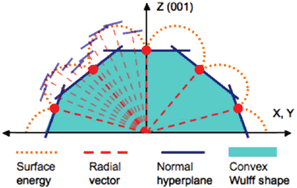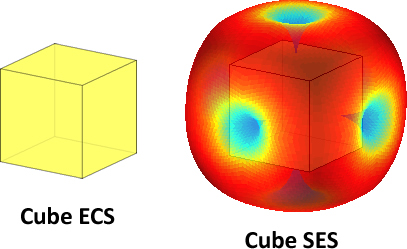I. Intro to Equilibrium Crystal Shapes and Wulff Constructions
Wulff’s classical theory is a (static) energy minimization algorithm which yields
the lowest energy crystal shape defined relative to an outer surface energy shape which is
governed by reconstructed atomic lattice surface energies and unique to a given chemical
composition. The surface energy at angle θ , γ (θ ) , is related to the expected crystal
shape by the following equation:
|
|

| |
Geometric construction of the Wulff shape based on anisotropic surface energy shape.
|
|
 |
(The Wulff Shape)
|
|
where θu is a unit vector in the θ direction, Rd is the real domain of d dimensions
containing all vectors x, and Sd−1 refers to a surface in polar (d=2) or spherical (d=3) coordinates. Wulff shapes represent the minimal surface energy orientation for a crystal
of a given volume, or equilibrium crystal shape (ECS). The Wulff shape is the convex
inner shape bounded by all tangents to an outer surface energy shape (SES). While a single, convex inner ECS is
implied by a given SES, there are an infinite number of SES
shapes that can correspond to any ECS shape, i.e. the Wulff
construction represents an irreflexive geometric set relation.
|
|
To the right, a 3D mapping of the ECS of a cube and a corresponding SES shape. The outer SES shape
shape is ‘false-colored’ according to the facet orientation energy (red being higher energy, and blue being lower energy facet
orientations), and displayed with transparency so that the inner ECS shape can be seen
within. The blue funnel shapes pointing inwards towards the facets indicate minima in the
SES corresponding to facets in the ECS, and the red regions indicate high-energy
orientations in the SES where facets are excluded from forming in the ECS.
|
|

| |
Cube ECS (left) and SES (right)
|
|
|